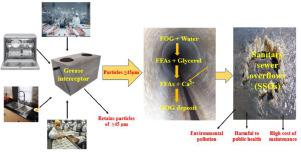Water Research ( IF 11.4 ) Pub Date : 2022-09-22 , DOI: 10.1016/j.watres.2022.119141 Nilufa Sultana 1 , Felicity Roddick 1 , Li Gao 2 , Mike Guo 2 , Biplob Kumar Pramanik 1

|
Treatment of wastewater with high levels of fat, oil, and grease (FOG), produced by the growing number (annually 2%) of food service establishments (FSEs), is a major concern for water utilities. About 30–40% of sewer blockages are caused primarily by the formation of FOG deposits in sewer pipes, and an annual additional maintenance cost is required for sewer management. To manage FOG deposition, FSEs are required to recover the FOG at the point of generation by installing grease interceptors (GIs) before release to the sewer system. The successful control of FOG deposition is largely dependent on clear understanding of its complex properties, pre-treatment processes, deposition mechanism and public awareness. The objective of this study is to provide a comprehensive understanding of the physicochemical properties of FOG, including particle size distribution and their removal efficiencies by existing GIs. Nowadays, generation of FOG particles of ≤45 µm is increasing because of the increasing use of automatic dishwashers. Current hybrid processes which comprise pre-treatment prior to GI use are ineffective since they are unable to completely remove particle sizes of ≤45 µm. Hence, there is potential for these particles to be released into the sewer system and eventually cause blockages. This critical review discusses the characteristics of effluents, including the particle size distributions generated from automatic dishwashers and handwash sinks. It concludes by providing some case studies and a perspective of the future opportunities to develop a novel GI process integrated with pre-treatment to remove particles of all sizes, including colloidal particles.
中文翻译:

了解脂肪、油和油脂的特性以及使用油脂拦截器去除它们
处理越来越多(每年 2%)的食品服务机构 (FSE) 产生的含有大量脂肪、油和油脂 (FOG) 的废水,是供水公司的主要关注点。大约 30-40% 的下水道堵塞主要是由于下水道管道中形成了 FOG 沉积物,并且每年需要额外的下水道管理维护成本。为了管理 FOG 沉积,FSE 需要通过在释放到下水道系统之前安装油脂拦截器 (GI) 在生成点回收 FOG。FOG沉积的成功控制很大程度上取决于对其复杂特性、预处理过程、沉积机理和公众意识的清晰认识。本研究的目的是全面了解 FOG 的物理化学性质,包括现有 GI 的粒度分布及其去除效率。如今,由于越来越多地使用自动洗碗机,≤45 µm 的 FOG 颗粒的产生量正在增加。当前包含在 GI 使用之前进行预处理的混合工艺是无效的,因为它们无法完全去除 ≤45 µm 的颗粒尺寸。因此,这些颗粒有可能被释放到下水道系统中并最终导致堵塞。这篇批判性评论讨论了废水的特性,包括自动洗碗机和洗手池产生的粒度分布。最后,它提供了一些案例研究和未来机会的展望,以开发一种与预处理相结合的新型 GI 工艺,以去除各种尺寸的颗粒,包括胶体颗粒。











































 京公网安备 11010802027423号
京公网安备 11010802027423号